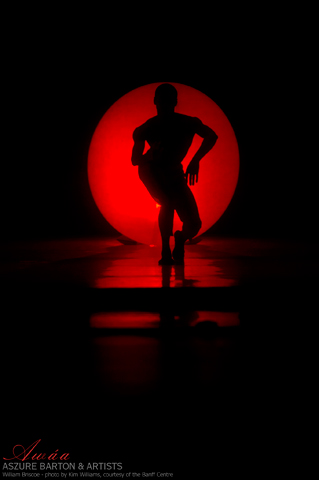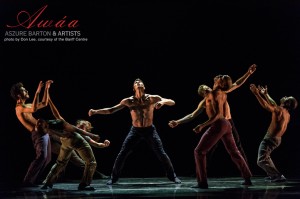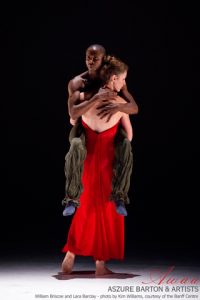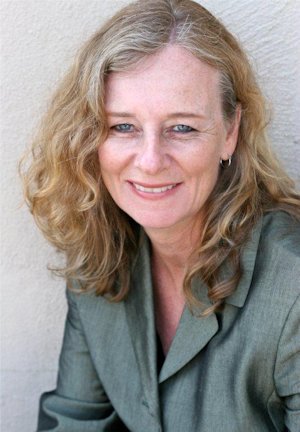Floating in the Dreamy Womb of Aszure Barton’s ‘Awáa’
While it sounds like agua, the Spanish word for water, Awáa is the Haida Gwaii word for “mother,” from the endangered language of native people in northwest Canada. And Awáa is a masterful dance experience, the gurgling creation story presented by Aszure Barton & Artists at UC San Diego’s Mandeville this week.

William Briscoe poses in front of the red hot balloon. Photo: Kim Williams
For a little more than an hour, we were pleasantly submerged and sent adrift down a dreamy river, led by the most gifted and flexible dancers I’ve seen in years.
Barton, a sought-after Canadian choreographer, was already creating Awáa in Banff with her dancers when she had a vivid dream that she was sitting underwater in a rocking chair. Her 2012 creation for six men and one woman has the quality of bodies and reeds pushed and twisted by currents. There’s a sense of time being slowed down, as when floating in water, in a peaceful weightless way.
A classically trained ballet dancer, Barton rejects familiar balletic forms. She has performed with the best and idolizes the late German choreographer Pina Bausch. In the opening scene, a contorted man appears in silhouette against a giant red ball. His knees quiver, his spine and hands deformed. In a trio, magnificent men wiggle and prance on half toe like giant Barbie dolls in drag. In groups, the men stomp as if slogging through mud.

The rippling men of Aszure Barton & Artists.
The underwater feeling is reinforced when they peer upward like fish and other sea creatures. After a sequence with lively African rhythms, it seems a raging river sends them to a beach on the other side of the world. Costumes by Linda Chow change several times and are mostly pale, as if fabrics were washed and pounded with river rocks, though there are bursts of red.
Lara Barclay conjures a delicate crane-like bird in backward arches yet holds her own against the pack of men. We don’t need the native Awáa translation of mother to know that Barclay represents steely yet nurturing feminine elements. Her duets with Tobin Del Cuore and Thomas House suggest romance, but then one morphs into a child. Still, she doesn’t hold him under. He just floats away.
In a brilliant red halter dress, she’s mom ready to go out on the town, but wrestles with little twin boys. They hang on her and skitter on tiny feet. How they transform from muscled men to infantile size is remarkable and convincing. Barclay becomes a giant with super mom strength. She yanks their arms and wants to be free of them but ultimately scoops them up and holds them tight. The image is both strange and heartfelt.

Lara Barclay as the mother carries her man baby, William Briscoe.
The music is beautifully strange too. Barton commissioned two scores, Lev Zhurbin’s luscious strings and soundman Curtis MacDonald’s percussion, water gurgles and blubs.
Bubbly sounds beckon visual bubbles in the form of red and white balloons of varied sizes. The largest red ball becomes a boiling sun. Dancers line up and sandwich balloons at their bellies to become human strands of DNA. Their arrival is the climax and most visually interesting part of the program.
[php snippet=1]
The production is so dynamic that it’s impossible to take in all of the elements: Man, woman, quick, slow, primordial soup, and infinite cosmos. Lighting, video, and props offer vague clues.
Perhaps gurgling water sounds represent the amniotic fluid womb, or the earliest forms of life. A black and white film of dancers depicting Barton’s underwater dream is grainy and pleasurable, not scary. Another video of dancers making fish faces suggests we view them as funny sea creatures, not humans. And while Barton thrills us with many perfect unison sequences, the movement in Awáa is off balance and enigmatic.
Couples embrace in odd ways, and dancers inch across the stage on their rumps, whirl their arms, and manipulate big balloons. Is it all about egg and sperm? The only spoken words are “take me to the river.” The arresting Barclay could have yelled, “Take me away from these man children!”
With one woman and a pack of men, one would expect dangerous encounters and violence, maybe a death by drowning. Barton’s Awáa is a peaceful floating world that avoids conflict. Men are magnificent rippling pacifists, the woman forgiving. We are left with the image of mother as nurturer as the curtain falls, and many curious ideas and symbols swirling above and below the water.

Kris Eitland covers dance and theater for Sandiegostory.com and freelances for other publications, including the Union Tribune and Dance Teacher Magazine. She grew up performing many dance styles and continued intensive modern dance and choreography at the Univ. of Minnesota, Duluth, and San Diego State Univ. She also holds a journalism degree from SDSU. Her career includes stints in commercial and public radio news production.
Eitland has won numerous Excellence in Journalism awards for criticism and reporting from the San Diego Press Club. She has served on the Press Club board since 2011 and is a past president. She is a co-founder of Sandiegostory.com. She has a passion for the arts, throwing parties with dancing and singing, and cruising the Pacific in her family’s vintage trawler. She trains dogs, skis, and loves seasonal trips to her home state of Minnesota.
